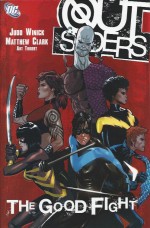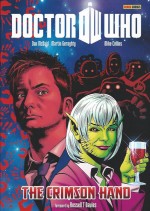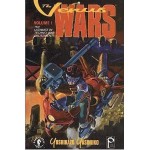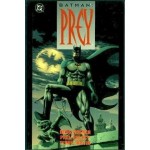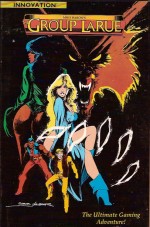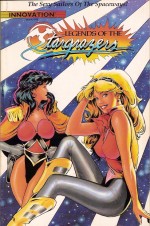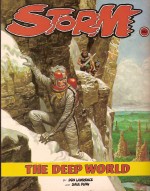

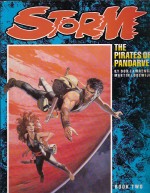
By Don Lawrence & Saul Dunn (British European Associated Publishers)
No ISBN
Storm: The Last Fighter & Storm: The Pirates of Pandarve
By Don Lawrence & Martin Lodewijk (Titan Books)
ISBN: 978-0-90761-077-9 and 978-1-85286-083-7
Don Lawrence, one of our greatest comics artists, is rightly revered for his stunning painted artwork on the legendary British weekly strip The Trigan Empire – which was the only reason most kids read the venerable knowledge-dispensing illustrated weekly Look and Learn – but his last and greatest work is largely unknown in the country of his birth. Over the years a number of publishers have attempted to sell a mass-market English-language edition of the Dutch-published science fiction serial Storm with little success, leaving only truly dedicated fans to purchase beautiful but painfully expensive limited-edition, leather-bound, hardback deluxe collectors compendiums.
Nevertheless, to my knowledge three softcover albums were released in the 1980s and still turn up occasionally so it’s worth keeping your eyes open for a stunning fantasy treat…
The concept was first conceived by Martin Lodewijk/Vince Wernham and Laurence in 1976 as a vehicle for the character Commander Grek but declined by Dutch publisher Oberon. Reworked by science fiction author Philip Dunn (who scripted the initial episode using the pseudonym Saul Dunn) with time-lost Terran astronaut Storm as the lead, the series was far more welcome, resulting in nine albums between 1978-1982, scripted by Martin Lodewijk, Dick Matena, Kelvin Gosnell and Lawrence himself, all fondly designated as the Chronicles of Deep World.
The rejected Commander Grek tale was eventually reworked into the continuity as episode 0 and after the series was rebooted Lawrence & Lodewijk produced a further 17 tales – “The Chronicles of Pandarve†– until the artist tragically lost much of his sight and was forced to retire in 1995.
In 1987 Titan Books took up the challenge of popularising the saga – a massive hit in Germany and the Netherlands, with editions also published in French, Italian, Spanish, Portuguese, Polish, Danish, Finnish, Greek, Croatian, Serbian, Bosnian and Indonesian – but gave up after two volumes…
Storm continued throughout Europe and is still being published today with Dick Matena, Romano Molenaar & Jorg De Vos handling the art.
The first epic, The Deep World by Lawrence and Dunn, was translated and released by British European Associated Publisher in 1982 and told in stunning, luxurious, fully-painted detail the story of astronaut explorer Storm, despatched by United Nations scientists in the 21st century to fly through the mysterious Red Spot of Jupiter. Unfortunately the valiant spaceman is trapped in those cyclonic crimson winds and propelled uncounted millennia into the future.
Dazed, lost and baffled by the seeming disappearance of the Red Spot, Storm spends a year flying back to Earth and discovers a world utterly transformed. His home world has become an icy wasteland, a Snowball Earth, but his desperate investigations uncover even more incredible secrets.
The oceans are gone and civilisation – such as it is – has relocated to the ancient sea floors. As he slowly makes his way down the miles of craggy dry depths, Storm is attacked by bandits who steal his space suit and survival kit, despite his violent resistance. Now clad only in the furs of the attacker he killed, Storm follows and encounters a fantastic planet of incredible jungles and bizarre beasts ruled by barbarian warlord Ghast.
Despite looking like a primitive thug Ghast is no fool: he knows the wearer of the strange clothes must be a commodity of great value and imprisons the wanderer in his dungeons where Storm meets a red-haired beauty called Carrots (alternatively Redhair and Ember) who is part of a secret tribe of knowledge-hoarders opposed to Ghast’s rule.
When her fellows rescue Carrots they take Storm with them and their leader Kiley reveals startling familiarity with the Astronaut’s story and equipment…
Taken to the subterranean land of Tome and a lost sub-surface sea, Storm is unaware that Ghast has tracked them deep below the surface of the Deep World. When they encounter a fantastic survivor from the age of technology and learn the secret history of Earth, Ghast refuses to accept what he sees and triggers a catastrophic explosion and flood…
The Last Fighter (Lawrence & Lodewijk) took up the tale with Storm and Carrots – now permanently dubbed Ember – washed ashore in a mountainous region which was once the Bahamas, where they are captured by slavers in a travelling circus/gladiator show.
Even held by deadly living insectoid shackles the bellicose Storm is a constant problem and when he acts up too openly in front of paying customers he finds himself made one city’s champion in a contest to capture the Throne of the Gods.
If he rebels Ember will be fed to a giant monster…
Competing against a number of other champions, Storm must invade the “Palace of Deathâ€, sit on “The Throne†and win “The Powers†for his city…
He complies and undertakes the lethal quest and discovers a huge, unexpected advantage: he is the only man alive who recognises the Palace as a crashed starship with all its deadly automatic defences activated and the throne as a captain’s command chair. Of course, that’s no real help when battling through the colossal booby-trapped corridors of the vast vessel to the off-switch, nor proof against the weapons of his rival champions or the schemes of the corrupt organisers of the contest…
After this Titan jumped immediately to the tenth tale, The Pirates of Pandarve, which saw an abrupt transition in the series as, after ages wandering the Deep World of Old Earth, Storm and Ember were suddenly catapulted into a universe of cosmic strangeness. Pandarve is a multiversal junction point where the laws of physics vary from moment to moment; a place of many worlds and planetoids with only localised gravity fields, circling an immense super-planet, all existing in a breathable atmosphere envelope instead of a special vacuum.
The pocket universe is ruled by power-mad dictator called Marduk, Theocrat of Pandarve – a man obsessed with temporal energy- whose long-range scanners detect an incredible chronal anomaly on Earth. Determined to possess the phenomenon at all costs, Marduk rips open the gateway of the multiverse and teleports Storm and the hapless collateral casualty Ember to Pandarve…
At that moment rebels attack the Theocrat’s citadel, disrupting the process and his targets materialise in space hundreds of miles above planet Pandave, shocked, terrified yet somehow still alive. Floating helplessly, the pair are rescued by an old man in a sailing boat hunting a space whale, but tragically when the monumental beast attacks Ember is lost…
When Storm and old man Rann reach his home asteroid they find a scene of devastation and the hunter’s daughter abducted by the bloodthirsty marauders of Vertiga Bas. The traumatised elder is saved from suicide by the time-lost Earthman and, believing Ember dead, they determine to pursue the pirates and rescue the stolen child.
Meanwhile, Ember has been picked up by Marduk’s men…
The searchers reach the outlaw habitat where Storm rescues Rann’s daughter in a truly unique manner, but soon falls foul of the Buccaneer city’s unique laws.
Condemned to the water-mines Storm’s last sight is of Ember, broadcast around the pocket universe as Marduk’s next bride…
The tragic hero has no idea that’s it’s all a ploy by the Theocrat to entrap the Anomaly…
In the mines Storm chafes under the trauma and pressure, his only friend the huge warrior called Nomad. With no real hope of success they begin to plan escape and revolution…
And that’s where, after a spectacular battle the magic, mayhem and majesty ends, with a freed Storm searching for his red-headed paramour in a scintillating, cliffhanging promise of more to come…
Those English-language hardback collectors editions were released way back in 2004, and now retail for astonishing amounts of money so surely it’s time for another go at a mass-market competitively priced run?
© 1982 Oberon bv – Haarlem – Netherlands – Don Lawrence/Philip Dunn.
© 1987 Oberon BV/Don Lawrence and Martin Lodewijk. UK edition © 1987 Titan Books, Ltd.
© 1987 Oberon BV/Don Lawrence and Martin Lodewijk. UK edition © 1989 Titan Books, Ltd.
